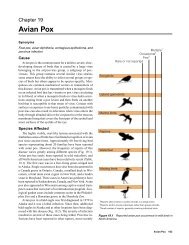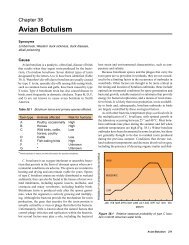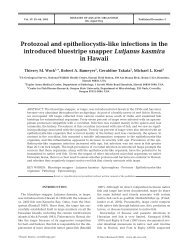Organophosphorus and carbamate pesticides - National Wildlife ...
Organophosphorus and carbamate pesticides - National Wildlife ...
Organophosphorus and carbamate pesticides - National Wildlife ...
You also want an ePaper? Increase the reach of your titles
YUMPU automatically turns print PDFs into web optimized ePapers that Google loves.
A<br />
Photo by J. Christian Franson<br />
B<br />
Photo by J. Christian Franson<br />
C<br />
Photo by J. Christian Franson<br />
D<br />
Photo by James Runningen<br />
Figure 39.6 Examples of food items found in the gastrointestinal tracts of birds that died from organophosphorus or <strong>carbamate</strong><br />
poisoning. (A) Pig remains from the crop of a bald eagle. (B) Bovine skin from the stomach of a bald eagle. (C) Bovine hair<br />
from the stomach of a magpie. (D) Corn in the esophagus of a mallard.<br />
cies, age, sex, <strong>and</strong> body condition, <strong>and</strong> because a diurnal<br />
ChE variation may occur in some species. The reactivation<br />
analysis described above, which is used to differentiate an<br />
OP- from a <strong>carbamate</strong>-induced intoxication when measuring<br />
brain ChE activity, can also be used to evaluate blood<br />
ChE activity. In live animals, a presumptive diagnosis can<br />
also be made by reversing the neurological signs with proper<br />
medical treatment.<br />
Specific compound residues may be identified in gastrointestinal<br />
contents. Mass spectrometry <strong>and</strong> gas chromatography<br />
are the usual analytical methods. Table 39.3 lists<br />
the compounds that were identified as the cause of mortality<br />
in the documented wild bird mortality events illustrated in<br />
Fig. 39.2.<br />
Table 39.3 Specific organophosphorus <strong>and</strong> <strong>carbamate</strong><br />
<strong>pesticides</strong> known to cause wild bird mortality events.<br />
Carbamates<br />
<strong>Organophosphorus</strong> compounds<br />
Carbofuran Chlorpyrifos Fenthion<br />
Methiocarb Diazinon Fonofos<br />
Oxamyl Dicrotophos Methamidophos<br />
Aldicarb Dimethoate Monocrotophos<br />
Disulfoton Parathion<br />
Famphur 1 Phorate<br />
Fenamiphos Phosphamidon<br />
Fensulfothion Terbufos<br />
1 Famphur is regulated by the Food <strong>and</strong> Drug Administration as a drug.<br />
Control<br />
When a die-off with a confirmed pesticide poisoning diagnosis<br />
has occurred, birds should be denied use of the pesticide-affected<br />
area. Carcass pickup is necessary to prevent<br />
secondary toxicity to scavengers <strong>and</strong> prevent mortality from<br />
other causes related to decomposing carcasses, such as botulism.<br />
Any remaining pesticide in bags, on treated seed, bait,<br />
or grain must be removed to prevent further mortality.<br />
292 Field Manual of <strong>Wildlife</strong> Diseases: Birds
















